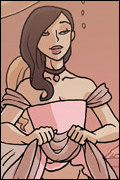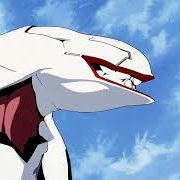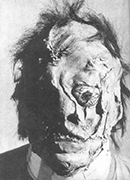|
I liked how originally Bilbo was supposed to get married and have kids in the first drafts of LotR, but eventually Tolkien decided to just make him a weird old "confirmed bachelor" who in another universe would be building time machines with his fretful nephew.
|
|
|
|
|

|
| # ? Jun 6, 2024 22:53 |
|
Data Graham posted:I liked how originally Bilbo was supposed to get married and have kids in the first drafts of LotR, but eventually Tolkien decided to just make him a weird old "confirmed bachelor" who in another universe would be building time machines with his fretful nephew. It was the middle of the night when Sam showed up. If there were hedges that needed trimming, they weren't outside in the dirt. (Or maybe they were? Maybe hobbits are into exhibitionism. I dunno.)
|
|
|
|
Well, if anybody finds anything better than the Hobbit movies and wants to share, I'll read it. Or if anybody finds anything unspeakably terrible that will make me simultaneously laugh and retch. I loving love terrible fanfiction and remember Legolas by Laura with fondness.
|
|
|
PMush Perfect posted:Seriously, if Bilbo isn't gay, I'll eat my Proudfeet. https://www.youtube.com/watch?v=gextz3oD634&t=189s
|
|
|
|
|
He did leave the Shire for Rivendell, consistently described as being full of exceedingly gay people.
|
|
|
|
Bag End's a queer place, and its folk are queerer.
|
|
|
|
skasion posted:While we're asking questions, here's a geography thing that I've never understood: is there a passage through the mountains into Mordor IN Minas Morgul, or do they just use the Cirith Ungol path whenever anyone needs to go through? I live to quote chapter and verse at times like this, and boy howdy do I enjoy being exceptionally pedantic. Strap in. The basic problem, I think, is that it's rarely made explicit what exactly Cirith Ungol is, and frequently both the characters and the narrator are very imprecise in their speech, as people often are with place-names. According to some translation thing I found on the internet, there is a little wriggle room over the Sindarin name "Cirith Ungol". "Ungol" is of course a spider, but apparently "Cirith" can mean both "pass" and "cleft". Perhaps it would help if we said that "Cirith Ungol" only applies to the gap in the mountain ridge that the pass goes through. Which does have some textual support. Chapter 8, book 4 (more on that chapter's title in a moment): quote:It seemed light in that dark land to his eyes that had passed through the den of night. The great smokes had risen and grown If we accept that only the cleft in the Ephel Duath is properly called "Cirith Ungol", the chapter title "The Pass of Cirith Ungol" should therefore be read as "The Mountain Pass that goes through Cirith Ungol", or possibly "The Method of Passing Through the place called Cirith Ungol", and not "The Mountain Pass that is called Cirith Ungol", and bollocks to what Faramir says when pronouncing his doom on Frodo. (In the same way that the Tower of Cirith Ungol would be "The Tower located on Cirith Ungol", not "The Tower that is called Cirith Ungol". And, when characters say "They went by Cirith Ungol" or "They went to Cirith Ungol", it is much more helpful if we read "They went through the cleft in the mountains", not "They used the mountain pass to get there". So, if it's unhelpful to refer to anything but the cleft as "Cirith Ungol", what should we call the mountain pass? A search of my ebook edition for "Minas Morgul" turns up this passage from the final march of the Army of the West on Mordor. quote:Now in their debate some had counselled that Minas Morgul should first be assailed, and if they might take it, it should be "The road that leads thence to the pass above". And it's a good enough road for the Brains Trust to be worried; even though their army is 7,000 strong, the Enemy can apparently send enough men over the pass and through Minas Morgul for it to be worth leaving a strong rear-guard at the Cross-roads. This is pretty clearly not the same route that Frodo, Sam, and Gollum take to get up to the cleft that is called Cirith Ungol, up the stairs that are literally crumbling away under only the weight of three hobbits. What we surely have here is two separate routes up the mountainside, each of which can be informally called "Cirith Ungol" because they are paths that go to Cirith Ungol. I think the best name for the "main road", the continuation of the road that runs from Osgiliath to Minas Morgul, is "Morgul Pass", which appears both there and as Sam looks down into Mordor from beside the Tower. quote:In that dreadful light Sam stood aghast, for now, looking to his left, he could see the Tower of Cirith Ungol in all its strength. These are both from The Return of the King. I wonder if what we're seeing here is Tolkien vacillating between different names, as we know he did all the time as he drafted and redrafted, in the gap between writing and publishing The Two Towers and RotK? In TTT he refers almost exclusively to "Cirith Ungol" as a catch-all, except for one moment as Frodo, Sam, and Gollum reach the top of the Straight Stair and prepare to tackle the Winding Stair. quote:At length they were once more aware of a wall looming up, and once more a stairway opened before them. Again they halted, This is the only use of "Nameless Pass" in the text I have, and I wouldn't be surprised if at some point in the future it gets altered to "Morgul Pass". I'm pretty sure that "Cirith Ungol", the cleft, consists of both the Morgul Pass over the top, overseen at the summit by the Tower of Cirith Ungol; and the route taken by the hobbits up the Stairs and through the caves of Torech Ungol, the Spider's Lair, which Gollum claims are "right through, the only way". I think he's not lying that Torech Ungol provides a way through the mountain without having to pass the Tower; although he does lie by omission, not telling them about Shelob; and also by not being around to guide them through the caves and down the other side (which we never see). Sam and Frodo only end up going through a cave that tips out near the Tower by accident, because that's where the fight with Shelob took them. So, Cirith Ungol is the Cleft, and there are two ways to get past the Cleft; the mainstream Morgul Pass and what I think I'm going to call the Stair-Lair route, for lack of anything else.
|
|
|
|
Eh. I appreciate the effort, but I don't think I see anything in there to suggest that Cirith Ungol and Morgul Pass aren't two separate passes through the mountains. And it's never how I've understood it. If both paths went through the same cleft, then we'd be talking about the Stairs climbing way, way up the side of the same notch that Morgul Pass is in, and I don't think any of the text supports that; yes, you can see down into Morgul Vale from the overlook at the end of one of the switchbacks, but my understanding is that from that point on you go through the tunnel and emerge in a small narrow cleft way high up in the peaks, and that is Cirith Ungol. Its entire point in the story is to be separate from Morgul Pass, an alternative route that nobody would expect them to take because it's ridiculously more difficult. I might be misunderstanding you, but your final paragraph seems to be saying you understand the "cleft" to be the entire pass through which both the Morgul Pass (the main road) and the Spider's Laid path go, and I don't think that makes any sense from a story standpoint or a geographical one. What am I missing?
|
|
|
|
|
skasion posted:Actually here's another Brandybuck question: why did they leave the Shire for Buckland? The Brandybucks were the original Shire-thains, back when they were the Oldbucks, but despite this they seemingly migrated out of the Shire and abdicated that office to the Tooks. Always struck me as just a weird thing. Buckland is consistently described as thickly settled, so it must have been fairly attractive and productive land, especially if the Marish has been improved through drainage in the interim. Hobbits are also notoriously legalistic, and as the office of Thain was descended from military ones under the kingdom of Arthedain, the Thains probably quickly became as ceremonial a position as they were by the time of the War of the Ring. Since the title was passed via election to the Tooks and didn't follow the normal rules of hobbit succession, we can also speculate that this was the normal course of action. Thus, Gorhendad Oldbuck would be leaving behind a ceremonial title dependent on acclamation for a colony outside Shire law where the title of Master/Mistress of Buckland would pass down according to traditional succession, and given the loyalty of the people of the Marish to Buckland close to 700 years later, probably the majority of the Oldbuck's actual power remained in their hands. It is worth noting that the hobbits of the Shire organized their society around broad extended family or clan lines, and that this neatly explains the relative underdevelopment of governmental infrastructure- the Bracegirdles of Girdley Island, for example, care for each other and for the poorer client families that reside in their territories. The Bagginses were upwardly mobile members of the middle class, (you can see how many prominent families Bilbo is related to at his birthday party) and as such lacked the established lands of Tooks or Longbottoms, but even then we can see the remnants of this relationship in Bagshot Row and in Bilbo's extensive generosity. Overall, the increasing urbanization of the Shire seems to have been an implied background element, and with this urbanization came class mobility, as neatly developed in Samwise Gamgee, seven times Mayor of Michel Delving, and his wife Rosie Cotton.
|
|
|
|
Speaking broadly of hobbits, something that I don't know if the podcasts/classes have made enough of—since it never really occurred to me until just now—is that although LotR is jam-packed full of hobbit characters and the intricacies of Shire life even before he got around to writing the Prologue, The Hobbit itself only has, like, the one. There's no other hobbits that even appear in it, except as offscreen references. The only impressions we even get of what hobbits are is through third-hand anecdotes and the narrator's own brief little monologue. Seems really bizarre at a high level that even when he was conceiving of LotR as a "Hobbit sequel", with no bigger scope than the original and really no story idea beyond "uhh maybe go to Erebor again, I dunno", he wrote the first few chapters as like a hobbit urban sitcom by comparison to the first book. Hobbits everywhere you look. Dozens of them, all with distinct personalities and family histories and everything, right out of the gate, and a whole ensemble of core cast members to play off each other. I know Olsen doesn't like to speculate about Tolkien's psychology or motivations, but sometimes I really wish he would, because there's something about the way he so self-consciously overcorrects and compensates for every perceived shortcoming in all his previous work I just find really relatable and endearing.
|
|
|
|
|
I find it very interesting that you see the big discussion about hobbits in the beginning of lotr as some kind of "overcorrection" for a "lack of hobbits" in the book where the title is "the Hobbit".
|
|
|
|
I mean, sure, I'm probably reading too much into it, but it's how I feel like I would overcorrect in that situation, so clearly that's what happened
|
|
|
|
|
Anyone here tried to listen to the Silmarillion film podcast?
font color sea fucked around with this message at 14:55 on Aug 29, 2017 |
|
|
|
Yes it was no good so I moved on
|
|
|
Data Graham posted:Speaking broadly of hobbits, something that I don't know if the podcasts/classes have made enough of—since it never really occurred to me until just now—is that although LotR is jam-packed full of hobbit characters and the intricacies of Shire life even before he got around to writing the Prologue, The Hobbit itself only has, like, the one. There's no other hobbits that even appear in it, except as offscreen references. The only impressions we even get of what hobbits are is through third-hand anecdotes and the narrator's own brief little monologue. I'd flip this around -- I think you've got it backwards, chronologically speaking. Remember, Tolkien did not write the stories first. He wrote the languages first, then the prehistory, then the history, and then the specific narratives. So while it's broadly true that he started writing the hobbit just out of the blue with a doodled line of "In a hole in the ground there lived a hobbit," I suspect that he had written, in some form or other, the extensive notes on hobbits, hobbit lives, hobbit society, etc., all as part of his background work while he was drafting The Hobbit or even before (which is why characters like Lobelia get mentioned in The Hobbit even if they remain off-stage). So I think what happened is he wrote The Hobbit thinking 1) the narrative focus should be on one single Hobbit not hobbits generally, and 2) he didn't expect anybody else to be interested in his cabinets-full of background notes on the history of hobbits, hobbit culture, hobbit genealogies, etc. Then he got a shitload of fan mail after The Hobbit was published and realized "oh wait, no, people actually want more of this? Ok then" and so it was easy to start LotR with a nice big infodump and give people what they apparently and surprisingly wanted. Keep in mind that Tolkien's creative process was kindof rear end backwards and weird. Like when he started writing Fellowship he knew a shitload about the Shire and shitload about the history of the First Age but in early drafts Strider was a hobbit named Trotter who had had his feet amputated by Sauron and walked with wooden clogs. He probably had the whole "Prologue: Concerning Hobbits" drafted out before The Hobbit even saw publication. Hieronymous Alloy fucked around with this message at 16:44 on Aug 29, 2017 |
|
|
|
|
Well... I mean the Prologue, Olsen says explicitly, definitely did not exist until long into the writing of LotR. He even goes over the point in time (I think the third draft, the fair copy) when he goes back and starts a new draft with a kind of cagily worded foreword that would one day evolve into the Prologue, casting the hobbits in a familiar but still clearly rudimentary light, most notably in that he describes them as being a relic of an older time in our own world—lovers of tilled earth and quiet hillsides and that's why we industrial-minded Big People don't see them anymore. The Hobbit narration style, in other words, but starting to make a clean break by saying the reader doesn't have to have read the earlier book to understand this one. So when you say you suspect he had the whole hobbit sociology thing all worked out before he ever set pen to "in a hole in the ground", how sure are you of that? I know that in a broad sense you're right about the linguistics-first approach he took to his older legendarium which had been around for like 20 years at that point already, but from what evidence I've seen The Hobbit was very much intended to stand alone apart from that whole universe, only tangentially touching it if at all (the Elvenking was a transplanted Thingol, Elrond was a recycled name, Mirkwood was an ersatz Taur-nu-Fuin, etc). It wasn't until halfway to Weathertop before he finally threw caution to the winds and said "gently caress it, let's bring Beren and Luthien into the hobbits' world" and formally started stitching the two creations together. My feeling is that his whole "Hobbit" world really was conceived in as close to isolation as he ever got, and he didn't set about fleshing out more of their world than was necessary until it became clear to him that his audience wanted a sequel.
|
|
|
|
|
William Contraalto posted:with this urbanization came class mobility, as neatly developed in Samwise Gamgee, seven times Mayor of Michel Delving, and his wife Rosie Cotton. Sam achieved his position via nepotism and other connections, not a widespread increase in class mobility within greater Hobbit society. The hero Hobbits and their families keep their positions of authority until death/retirement. The Shire is a picture of social stagnation both before and after the events of the books. edit: Ah, you also said the Bagginses were middle-class. Good troll, well played. sassassin fucked around with this message at 18:06 on Aug 29, 2017 |
|
|
|
Even before Bilbo came back with a load of treasure, he owned property and lived comfortably off the profit it brought him. However, "middle class" means something different in post-WW2 America than in pre-WW1 England, and I think that's worth examining.
|
|
|
|
The Baggins family were upper class toffs. They're old money. The middle class flocked to a Baggins party because of how much fancy swag they'd give out. The poors got to clean up the day after. The Gamgees - servants of the Baggins family for generations - were granted special dispensation to attend.
|
|
|
|
sassassin posted:The Baggins family were upper class toffs. They're old money. The middle class flocked to a Baggins party because of how much fancy swag they'd give out. The poors got to clean up the day after. They're not old money. The old money in the Shire holds land. They're middle-class, almost definitionally bourgeois (Tolkien himself noting that the coincidental phonetic similarity to Babbitt is marked by hobbits having his "bourgeois smugness") because the Bagginses have money by having cash, capital, investments. They have married into old-money families like Tooks, Brandybucks, Bracegirdles, Chubbs and Grubby, Proudfeet, etc. They have Bagshot Row, but not the rest of Hobbiton. sassassin posted:Sam achieved his position via nepotism and other connections, not a widespread increase in class mobility within greater Hobbit society. The ability of a working-class hobbit to achieve a position of political power through personal connections still represents an increase in class mobility from feudal/heroic society, and more broadly, Hobbiton and Bywater exist outside the patron-client class relationships Tolkien indicates exist in the rest/past of the Shire in sources like Letter no. 214. The Sandymans are clearly not paying Bilbo or Frodo rent, whether in cash or in kind. It's actually unlikely the Bagshot Row residents are paying rent, either.
|
|
|
|
Data Graham posted:Well... I mean the Prologue, Olsen says explicitly, definitely did not exist until long into the writing of LotR. He even goes over the point in time (I think the third draft, the fair copy) when he goes back and starts a new draft with a kind of cagily worded foreword that would one day evolve into the Prologue, casting the hobbits in a familiar but still clearly rudimentary light, most notably in that he describes them as being a relic of an older time in our own world—lovers of tilled earth and quiet hillsides and that's why we industrial-minded Big People don't see them anymore. The Hobbit narration style, in other words, but starting to make a clean break by saying the reader doesn't have to have read the earlier book to understand this one. This is kind of inaccurate. In the very first drafts, the Necromancer is Thû/Sauron and Gandalf/Bladorthin says that Beren and Luthien broke his power recently. Elrond at this point may have been conceived to have a close to normal human lifespan. The references to "warriors fighting another in distant lands" appear to have been a reference to the battles against Morgoth. But Tolkien realized that there was a fundamental discrepancy with Orcrist and Glamdring having been lost so long ago and yet the fall of Gondolin happening maybe 50 years ago. So Tolkien revised in favor of placing the story in the distant future of the Silmarillion material, and cut out or altered these references. Simultaneously, Tolkien was also struggling on where to place The Lost Road and Numenor chronologically with respect to the Silmarillion material, placing it contemporaneous or earlier or a short distance into the future. Given the anachronistic aspects of the first edition of The Hobbit, like bicycles, it is interesting to speculate on the paths that might have been taken if the contemporaneous approach had been used, especially with the implication of Thingol's survival. William Contraalto fucked around with this message at 21:39 on Aug 29, 2017 |
|
|
|
William Contraalto posted:This is kind of inaccurate. In the very first drafts, the Necromancer is Thû/Sauron Speaking of which, is there any explanation anywhere of why he's called the Necromancer? Was he claiming to communicate with the spirits of the dead, or is the word just being used in the broader sense of someone who uses evil magic?
|
|
|
|
Silver2195 posted:Speaking of which, is there any explanation anywhere of why he's called the Necromancer? Was he claiming to communicate with the spirits of the dead, or is the word just being used in the broader sense of someone who uses evil magic? There's no direct notes or other explanations that I am aware of. That said, on a basic level Sauron is a necromancer in the sense contemporary fantasy uses it, since he has his undead Nazgul, used to have a vampire, and in early drafts of the Lord of the Rings, a whole lot of other undead servants, along with werewolves, which are classically considered an undead creature. And a necromancer in the classical sense, since he interrogates these undead creatures for information. But this is almost certainly Tolkien revising in order to provide an explanation for an concept mentioned in brief. Most likely is that Tolkien, who wrote The Hobbit with the potential for it to be set in Beleriand, wished to make Mirkwood/Taur-nu-Fuin spookier, more horrifying, than the mere presence of orcs/goblins provided, a place that Beren might credibly see horrors he never spoke of again. And thus, while the portion of the forest near the Wood-Elves/Doriath merely has staring eyes and the possibility of spiders and Fair Folk tomfoolery, the parts where Sauron has fled to need to be even worse. Thus, we go to the walking dead and ghouls and ghosts, but they are left as intimations on the edge of the tale, as they would be throughout the Legendarium material. (In plot notes, Tolkien also considered incorporating cannibals at the end of the Mirkwood road as an episode, from his poem "The Mewlips"). In addition, necromancy in the classic sense of course has a certain biblical significance with the Witch of Endor and Saul summoning up the deceased Samuel for aid. The Numenor material used for The Lost Road immediately features the quest for immortality and necropolis motifs (though in quite different form) and Sauron always featured heavily in them. But that material was written after The Hobbit was completed so it's not an influence on the Hobbit. There may be some now-invisible source that Tolkien was drawing upon for both. Now, imagine if Sauron had remained Tevildo, Prince of Cats...
|
|
|
|
what happened to the vampire also necromancer could easily have been drawn from the term negromancer, a medieval term for one who practices black magic (negromancy) which tolkien then changed because of the implication
|
|
|
|
|
chernobyl kinsman posted:what happened to the vampire Luthien flayed her alive and wore her skin as a coat. She was then either eaten by a dog or crushed by falling masonry.
|
|
|
William Contraalto posted:Luthien flayed her alive and wore her skin as a coat. She was then either eaten by a dog or crushed by falling masonry. that's badass. i don't remember that; is it in the Sil?
|
|
|
|
|
William Contraalto posted:There's no direct notes or other explanations that I am aware of. That said, on a basic level Sauron is a necromancer in the sense contemporary fantasy uses it, since he has his undead Nazgul, used to have a vampire, and in early drafts of the Lord of the Rings, a whole lot of other undead servants, along with werewolves, which are classically considered an undead creature. And a necromancer in the classical sense, since he interrogates these undead creatures for information. But this is almost certainly Tolkien revising in order to provide an explanation for an concept mentioned in brief. Sauron may have also always been a fiddler with death, and JRR may have never actually written that part down or tossed/burned the papers where he made that clear 
|
|
|
|
chernobyl kinsman posted:that's badass. i don't remember that; is it in the Sil? It's in Beren and Luthien, at least.
|
|
|
chernobyl kinsman posted:that's badass. i don't remember that; is it in the Sil?
|
|
|
|
|
I thought Thuringwethil was more a coworker of Gorthaur's than a subordinate? I mean why NOT have your lieutenants be a werewolf and a vampire, right Morgoth
|
|
|
|
There are werewolves in lord of the rings and they are loving freaky .
|
|
|
|
euphronius posted:There are werewolves in lord of the rings and they are loving freaky . Plz refresh my memory. Do you mean the books or the whole setting?
|
|
|
|
euphronius posted:There are werewolves in lord of the rings and they are loving freaky . Not sure if this has already been covered but are there 'classic werewolves' whatever the gently caress that means or do you mean how in The Silmarillion Tolkien calls the wargs werewolves and I believe in that draft the big difference beyond the name was that the wolves actually are dead servants of Morgoth given wolf bodies to roam around in and gently caress people up with? Memory might be off by half on this. A quick peak at the wiki says Sauron took the form of a wolf though I don't remember when he did that, which would be the traditional use of the word. I think huge wolves with evil spirits in them is the more ridiculous and good idea anyway extra stout fucked around with this message at 05:42 on Aug 31, 2017 |
|
|
|
Silver2195 posted:Speaking of which, is there any explanation anywhere of why he's called the Necromancer? Was he claiming to communicate with the spirits of the dead, or is the word just being used in the broader sense of someone who uses evil magic? There's only one reference that I know of, in Morgoth's Ring. Bolding mine. pg. 223–224 posted:The fëa is single, and in the last impregnable. It cannot be brought to Mandos. It is summoned; and the summons proceeds from just authority, and is imperative; yet it may be refused. Among those who refused the summons (or rather invitation) of the Valar to Aman in the first year of the Elves, refusal of the summons to Mandos and the Halls of Waiting is, the Eldar say, frequent. It was less frequent, however, in ancient days, while Morgoth was in Arda, or his servant Sauron after him; for then the fëa unbodied would flee in terror of the Shadow to any refuge—unless it were already committed to the Darkness and passed then into its dominion. In like manner even of the Eldar some who had become corrupted and refused the summons, and then had little power to resist the counter-summons of Morgoth. Basically dead Elves are dicks and Sauron has a host of them at his disposal. Falathrim fucked around with this message at 05:43 on Aug 31, 2017 |
|
|
|
Ashcans posted:Yes, I believe there is a path directly through Minas Morgul to access Mordor; the hobbits don't take it because it means passing directly through the fortresses and in the busiest areas, where they are very unlikely to get through (maybe Frodo on his own if he was using the ring). Especially because at the time they arrive, the forces are mobilizing so there is lots of traffic/people running around. Frodo would have had no chance of going that way. If he didn't use the ring, he'd be caught. If he used the ring, the Nazgul would probably immediately sense him there. When the hobbits arrive there in the book it's right when the Witch King and his armies are moving out and the Witch King actually pauses before marching out and seems a bit troubled which seems to imply that he has sensed Frodo despite Frodo not even wearing the ring at the time. The way they went was pretty much the only way. Go through Barad-Dur and Sauron will catch you when you put on the ring. Go through Minas Morgul and the Nazgul will sense it when you put on the ring. Go through Shelob and you're probably hosed too but at least it's not a guarantee.
|
|
|
extra stout posted:Not sure if this has already been covered but are there 'classic werewolves' whatever the gently caress that means or do you mean how in The Silmarillion Tolkien calls the wargs werewolves and I believe in that draft the big difference beyond the name was that the wolves actually are dead servants of Morgoth given wolf bodies to roam around in and gently caress people up with? Memory might be off by half on this.
|
|
|
|
|
Falathrim posted:There's only one reference that I know of, in Morgoth's Ring. Bolding mine. Huh. So Tolkien actually did conceive of him as a necromancer at some point. Weird that it never comes up in Lord of the Rings; we actually see Aragorn doing more necromancy than Sauron, heh. Silver2195 fucked around with this message at 07:11 on Aug 31, 2017 |
|
|
|
extra stout posted:Not sure if this has already been covered but are there 'classic werewolves' whatever the gently caress that means or do you mean how in The Silmarillion Tolkien calls the wargs werewolves and I believe in that draft the big difference beyond the name was that the wolves actually are dead servants of Morgoth given wolf bodies to roam around in and gently caress people up with? Memory might be off by half on this. Werewolves not common wargs. THe fellowship was attacked by them in Hollin. euphronius fucked around with this message at 12:43 on Aug 31, 2017 |
|
|
|
Ginette Reno posted:Frodo would have had no chance of going that way. If he didn't use the ring, he'd be caught. If he used the ring, the Nazgul would probably immediately sense him there. When the hobbits arrive there in the book it's right when the Witch King and his armies are moving out and the Witch King actually pauses before marching out and seems a bit troubled which seems to imply that he has sensed Frodo despite Frodo not even wearing the ring at the time. Angmar or someone in Minas Morgul must have sensed Frodo on some level, because Gorbag's patrol was told to come up the stairs to the tower of Cirith Ungol to look for spies.
|
|
|
|

|
| # ? Jun 6, 2024 22:53 |
euphronius posted:Werewolves not common wargs. You sure about this? I don't remember werewolves.
|
|
|
|





























